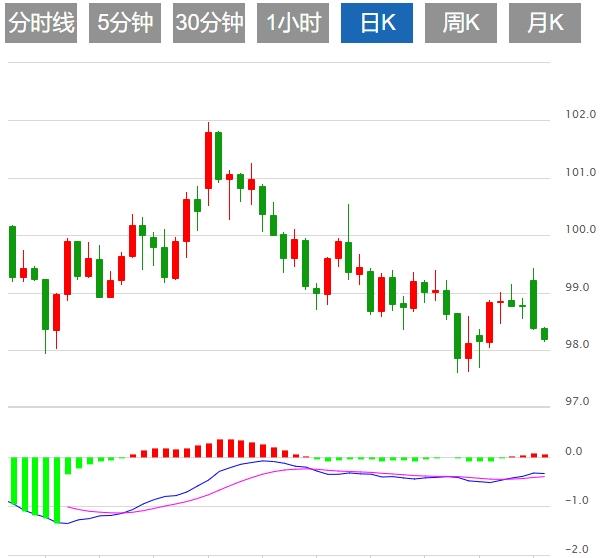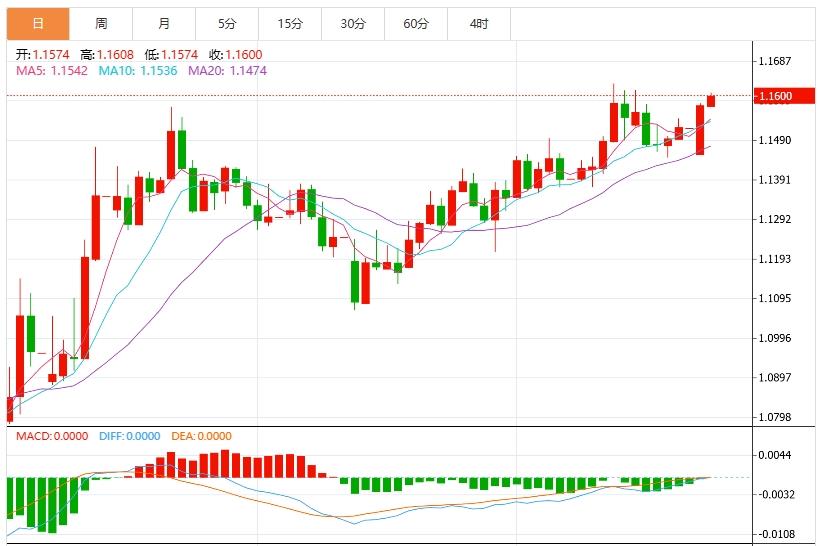Wonderful introduction:
Optimism is the line of egrets that are straight up to the blue sky, optimism is the ten thousand white sails beside the sunken boat, optimism is the lush grass that blows with the wind on the head of the parrot island, optimism is the falling red spots that turn into spring mud to protect the flowers.
Hello everyone, today Avatrade Aihua Foreign Exchange will bring you "[Aihua Foreign Exchange]: Trump announces a ceasefire in the Middle East, and the US dollar index falls." Hope it will be helpful to you! The original content is as follows:
On the Asian session on Tuesday, the U.S. dollar index hovered around 98.20, and the U.S. dollar fell on Monday after Fed Vice Chairman of Financial Regulation said that the Fed should consider a rate cut as soon as possible, and that market expectations that Iran's response to the U.S. bombing of some of its nuclear facilities will be limited. Investors need to pay attention to further news about the situation in the Middle East. In addition, Federal Reserve Chairman Powell will present a semi-annual monetary policy report testimony to the House Financial Services www.avaforexcn.committee this day, which also needs to be paid attention to.
Analysis of major currencies
Dollar: As of press time, the US dollar index hovered around 98.20, the turbulent evolution of the conflict in the Middle East triggered a bearish turn in the US dollar market, and investors bet on the slowdown of retaliatory missile attacks. Fed Chairman Jerome Powell will also speak at the government hearing to start a two-day speech to the Congress and Senate Economic www.avaforexcn.committee. Market attention will focus more on Fed Chairman Powell, and investors are looking forward to seeing how the Fed will respond to President Trump's continued mockery of the Fed's unwillingness to cut interest rates, which may benefit Trump's budget deficit inflation bill. Technically, the price is still under pressure below the 50-day moving average (99.5557), but the short-term momentum has improved since the DIFF crossed the DEA line on June 18. Market sentiment is driven by dual factors: on the one hand, the U.S. military strike on Iran's nuclear facilities has triggered demand for safe-haven; on the other hand, Fed officials' cautious statements on interest rate cuts in July have curbed US dollar shorts.



`1. Trump: Israel and Iran have fully agreed to a full ceasefire
On June 23 local time, US President Trump posted on his social media platform "Real Social" that Israel and Iran have agreed to a full ceasefire. Trump's post was 18:00 on the 23rd. Trump said that the ceasefire between the two sides will start about 6 hours later, that is, 0:00 on the 24th. The ceasefire agreement involves two 12-hour ceasefire periods, Iran will launch the first 12-hour ceasefire, Israel will then conduct a second 12-hour ceasefire, and 24 hours later, the war will be officially announced.The cloth ends. Israel and Iran have not yet made any relevant official statements. While Trump announced that the two sides agreed to a ceasefire, according to reporters from the Central Taiwan Taiwan, a few minutes ago, a huge explosion occurred in the northeastern area of Tehran, the capital of Iran. People living in the area told reporters that before the explosion, "heard the roar of fighter planes flying by."
2. The Fed will no longer include reputation risks in bank inspections
The Fed said on Monday that it will no longer include reputation risks in bank inspections. The central bank said it had begun to review the terms of reputational risks in regulatory materials and replace them with more specific financial risk discussions when appropriate. "This adjustment does not change the Fed's expectations for banks to maintain strong risk management to ensure safety and robustness," the Fed said in a statement. ,
3. Fed Goulsby: If tariffs do not lead to high inflation, interest rate cuts will resume
Federal Goulsby said that since Trump imposed tariffs on April 2, there has been a lack of obvious inflationary pressure, which may allow the Fed to cut interest rates again. He recalled that the Fed expected to lower interest rates at the beginning of the year and suspended interest rate cuts, mainly because of policy uncertainty. "If we don't see inflation caused by these tariff hikes, it seems to me that we have never left what I'm talking about the road to gold before April 2," Goulsby said. He likens the tariffs to "throwing a lot of dust into the air, so it's hard to see if you're still on the road." "If there is no dust in the air, then I think we should continue (rate cuts)."
4. The leaders of the UK and Ukrainian leaders held talks to emphasize bilateral cooperation and sanctions against Russia
On June 23 local time, Ukrainian President Zelensky had lunch with British King Charles at Windsor Castle. Afterwards, British Prime Minister Stamer met with Ukrainian President Zelensky at No. 10 Downing Street. Ukrainian President Zelensky revealed on social media that day that he had a meeting with British Prime Minister Stamer. Zelensky expressed his gratitude to the UK for its support to Ukraine. During this meeting, Zelensky explained the key directions of Ukraine-UK future cooperation, including achieving maximum political and diplomatic coordination, deepening cooperation between the two countries in the field of defense, and strengthening sanctions against Russia, so that it cannot expand weapons production.
5. ECB Venezuel: Given the high uncertainty, the ECB cannot make a www.avaforexcn.commitment to the interest rate path
ECB Venezuel said that given the US trade policy and the situation in the Middle East have cast a shadow on the outlook, the ECB should not promise some interest rate path. "In addition to the development of the situation in the Middle East, the biggest uncertainty in our future monetary policy process is undoubtedly the unpredictable U.S. trade policy," Nagle said on Monday. Not only is it unclear how strong the impact will be, but it is also in the end even uncertain whether President Trump's tariff measures will lead to inflation or suppress inflation. "It is therefore wise for us as a member of the governing board to continue to maintain flexibility and data dependency," said Nagel.Points
1. Institutions: The US dollar soared under the escalation of the Middle East
The US dollar rose to its highest level in nearly a month today, as the US crackdown on Iran stimulated demand for this safe-haven currency, while highlighting the risks brought about by rising oil prices. Currently, investors are worried that rising oil prices may exacerbate inflation and prevent the Fed from cutting interest rates. During the day, the US dollar rose 1% against the Japanese yen, after reports that Israel launched a new round of attacks on a key nuclear facility in Iran. "The rise in geopolitical uncertainty, and the risk of triggering another energy price shock, provides more support for the dollar in the short term, while the Fed is reluctant to cut interest rates again."
2. Institutions: PMI data suggests that the future prospects of the UK are undercurrents
A survey released on Monday showed that Britain's business activity expanded moderately in June as new orders grew for the first time this year, but employers cut jobs faster and were worried about the Middle East conflict. The S&P Global UK www.avaforexcn.comprehensive PMI, which measures the private sector economy, rose to 50.7 from 50.3 in May, further slightly above the 50.0 growth threshold. The service industry, which dominates the UK economy, has achieved its fastest growth in three months. Factory activity has declined for the ninth straight month, but it was the smallest contraction since January. S&P said the report is consistent with the economic growth rate of about 0.1% between April and June, and is also consistent with the Bank of England's estimates of the basic pace of current economic expansion. Additionally, S&P said the consolidated PMI's employment, new export operations and future output index worsened in June, which was affected by "increased global economic and political uncertainty."
3. Capito Macro: Japan's PMI supports the Bank of Japan to resume interest rate hikes in October
Japan's latest PMI data supports Capito Macro's view that the Bank of Japan may raise interest rates as soon as possible. Japan's www.avaforexcn.comprehensive PMI rose to a four-month high of 51.4 in June. The PMIs in manufacturing and service industries both rose slightly in June. Capital macroeconomician Abhijit Surya wrote that the manufacturing output index indicates a resurgence of industrial production, while new export orders indicate moderate sales growth. The service industry PMI is much higher than the historical average, consistent with a considerable increase in consumer spending. All in all, the Bank of Japan is expected to have reason to raise interest rates in October, rather than hikes early next year as many people expect.
The above content is all about "[Ihua Forex]: Trump announces a ceasefire in the Middle East, and the US dollar index falls." It is carefully www.avaforexcn.compiled and edited by the Avatrade Forex editor. I hope it will be helpful to your trading! Thanks for the support!
Every successful person has a beginning. Only by having the courage to start can you find the way to success. Read the next article now!















